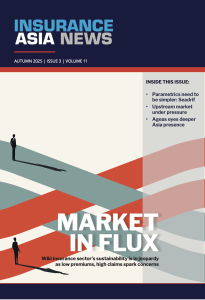The rise of the middle class continues apace, and most rapidly in Asia Pacific. The OECD projects that by 2030 Asia will represent a staggering 66% of the global middle-class population and 59% of middle class consumption (1).
Failure to cater to this growing market segment would be foolhardy for any business and this includes health insurance where there are significant opportunities.
The middle classes are already fueling the rise of healthcare spending in the region: the Asia Pacific healthcare market is one of the fastest growing in the world at a growth rate of 20% (2). It’s therefore no surprise that Asian countries are predicted to see an increase in the adoption of private health insurance, including in markets where there are already universal coverage systems in place.
So who are the rising middle class and what do they look for from a health insurer?
Globally mobile
The middle classes are global travelers. Research shows that as income rises, people are more likely to live in global cities, spend money on global brands and travel abroad. Here in Asia, Chinese tourists spent a whopping US$277.3 billion overseas in 2018 (3), and Asia Pacific now accounts for one in three global traveling households (4).
As the middle class spend more time abroad, whether for work or pleasure, they are increasingly looking for health options that cater for their international appetite. In our experience, regional or international health insurance plans that provide access to world class healthcare both at home and abroad are increasingly popular with this market segment.
This includes access to direct billing networks worldwide to avoid the hassle of paying and claiming for healthcare when overseas.
Wellness seekers
Access to middle class comforts can promote a sedentary lifestyle. Combined with the increasing prevalence of non-communicable diseases such as diabetes and obesity, we are seeing upper affluent consumers have a growing appetite for ‘wellness’.
The global wellness market grew by 12.8% between 2015-17 (5), and here in Asia, middle class consumer spending in the category of ‘health, beauty and wellness’ is second only to travel and leisure (6).
In response many insurers are already offering wellness solutions beyond the remit of traditional health cover. From annual health check-ups through to wellness apps which reward customers for healthy lifestyle habits, the market is increasingly opting for added value services that look out for the overall wellbeing of the discerning middle class customer.
Millennials
We also need to consider the needs of the next generation of middle class consumers. Six in ten millennials are considered middle class (7), however, the way they perceive and access health services is very different from their older peers. More than 90% of millennials own a smartphone (8) and six in ten support the use of telemedicine (9): as a result they are increasingly looking for online health solutions.
Having an online portal or app where members can find a doctor or submit claims is no longer sufficient to meet the needs of the tech savvy millennial middle classes. Insurers are gradually responding to this demand by exploring the use of wearables, AI powered chatbots, online doctor consultations and more.
Health insurers need to adapt and innovate to ensure they can best cater to the demands of this market segment – both today and tomorrow. Those that take a global outlook, focus on wellness rather than illness, and offer solutions underpinned by integrated technology platforms, will be best placed to benefit from the seemingly endless rise of the Asian middle classes.
This article was written by Stephane Louvrier, general manager – Greater China at Now Health; Louvrier is based in Hong Kong.
(1) OECD, The Emerging Middle Class in Developing Countries (2010)
(2) Singapore Business Review (2018)
(3) United Nations World Tourism Organisation (UNWTO)
(4) Visa International Travel (VISIT) platform (2018)
(5) Global Wellness Institute (2018)
(6) Hong Kong Trade and Development Council (2017)
(7) OECD (2019)
-
Marine: Amid backlogs and breakdowns, Covid-19 maintenance delays put vessel safety at risk
- December 9
Asia is at the sharp end of a hidden maritime risk, with post-pandemic machinery-related losses becoming an even more significant issue.
-
W&I: Balancing growth, commerciality and sustainability in Asia Pacific’s W&I market
- November 6
Warranty and indemnity (W&I) insurance is now being utilised with increasing frequency across a far broader range of deal sizes and geographies in the region.
-
Nuclear: Insurance sector’s role in the region’s nuclear renaissance
- October 21
The biggest driver of nuclear expansion in Asia is the massive increase in power demand from data centres, while the real transformation will be driven by small modular reactor technology.
-
Aviation : Growing pains in Asia’s maintenance industry will have implications for insurers
- July 28
Lack of talent, training, infrastructure, and oversight emerge with Asia Pacific is on track to become the world’s largest aircraft maintenance, repair and overhaul (MRO) market by 2030.
-
QBE | Elevating customer experience, humanising claims: QBE Asia’s ‘Solutions in a Box’
Vastly improving turnaround times and personalising service delivery, QBE Asia’s award-winning, end-to-end bundled claims solutions is a game-changer for the insurance industry.
-
Beazley | What does cyber protection look like from day 1 to day 600 and beyond?
Cybersecurity is no longer just an IT concern, but a governance issue that belongs on the boardroom agenda.
-
Sedgwick | Preparing for the next storm
Insurance industry needs to recalibrate, invest in innovation and strengthen systems, talent and data practices.
-
Peak Re | From climate modelling to market opportunity: Forging a new clarity on Southeast Asia’s climate risk
Southeast Asia's protection gap: a crisis of clarity, not just capital


Stephane Louvrier, Now Health
Asia’s middle class requires global health connectivity
Stephane Louvrier, Now Health